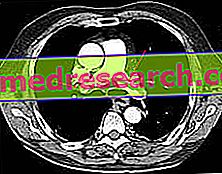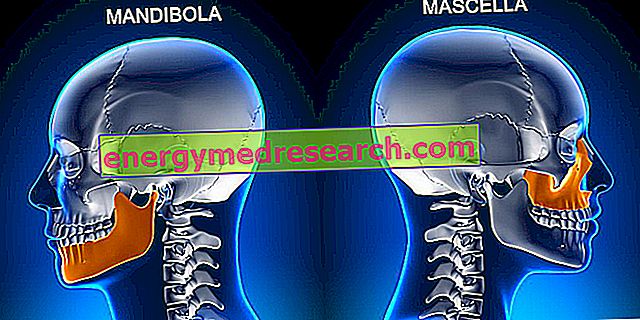Premise
Erectile dysfunction is the inability to have or maintain a satisfactory penile erection, even when good sexual desire is present.

Exams and Diagnosis
A correct diagnosis of erectile dysfunction focuses mainly on physical examination and medical history .
In fact, these two diagnostic investigations allow not only to identify the presence of an erection difficulty, but also to establish, on the basis of any concomitant symptoms, the potential causes or tests to identify them.
Physical examination and medical history
The physical examination is the set of diagnostic maneuvers, carried out by the doctor, to verify the presence or absence, in the patient, of signs indicative of an abnormal condition.
- In the case of erectile dysfunction, the physical examination consists substantially in the palpatory analysis of the penis and testicles, aimed at assessing the cutaneous sensitivity of these anatomical regions (the presence of skin sensitivity is an indication of good nerve health).
The anamnesis, on the other hand, is the collection and critical study of symptoms and facts of medical interest, reported by the patient or his family members.
- In the case of erectile dysfunction, the anamnesis focuses mainly on three aspects: the patient's sexual life, the symptomatological characteristics of the reported difficulty in erection and the search for factors favoring / determining this difficulty.
It is above all what emerges from the anamnesis to decide whether or not other more in-depth diagnostic tests are necessary.
What does the investigation of the patient's sex life involve?
For a good investigation of his sexual life, the patient must overcome all embarrassment and speak openly with the doctor who interrogates him.
Typical questions are about: previous and current sexual relationships, sexual orientation, duration of erection problems, ejaculation, orgasm and sexual desire.
Diagnostic tests to understand the causes
Among the in-depth diagnostic tests, which can help the doctor establish the precise causes of erectile dysfunction, are:
- Blood tests . They allow the identification of conditions such as diabetes, heart diseases, pathological reduction of blood testosterone levels (hypogonadism) and many other health conditions associated with erectile dysfunction.
- Urine tests . In a similar way, blood tests allow us to highlight the presence of diabetes and other diseases capable of causing erectile dysfunction.
- Monitoring of the phenomenon of nocturnal penile tumescence . It consists of a test that measures, for three consecutive nights, through ring detectors at the base and on the tip of the penis, spontaneous erections during sleep. When the penis is erected, the aforementioned ring detectors measure tumescence and rigidity.
Monitoring the phenomenon of nocturnal penile tumescence is not always a highly reliable test.
- Measurement of sacral evoked potentials (PE) . It is a neurological examination, which allows to study the electrical conduction of sensory and motor stimuli which, respectively, come from, and reach, the genital area along the pudendal nerve and the sacral marrow.
In the presence of erectile dysfunction, the measurement of sacral evoked potentials clarifies whether, at the origin of the difficulties of erection, there is a neurological problem, which compromises the cutaneous sensitivity or the control of the bulbocavernosus muscle.
- The penile echocolordoppler . Painless examination, is a special ultrasound of the penis that allows to study the flow of blood within the arterial vessels of the corpora cavernosa.
Sometimes, this diagnostic test involves the injection into the corpus cavernosum of a vasoactive drug, which stimulates an erection, in order to observe the progress of the arterial circulation inside the penis, during its hardening ( dynamic penile echocolordoppler ) .
- Dynamic cavernosometry and selective dynamic arteriography of the penile arteries . These are two much more thorough and invasive radiological examinations of the penile echocolordoppler and of the dynamic penile echocolordoppler, which make it possible to identify the exact location of a problem in the blood vessels of the cavernous bodies.
Clearly, the attending physician prescribes such tests only after having secured, by means of a penile echocolordoppler, that there is a vascular condition at the origin of erectile dysfunction.
- A psychological assessment . It serves to establish whether or not the present erectile dysfunction has a psychological origin.
Care and Treatment
See also: Drugs for erectile dysfunction treatment
To treat or try to cure erectile dysfunction, the doctor must plan an adequate causal therapy, that is a therapy against the cause that causes erection deficits.
Therefore, based on some factors (eg: patient's health, severity of erectile dysfunction, etc.), and also on the basis of the same cause, he can add a sort of symptomatic treatment to the aforementioned causal therapy, which helps the individual with problems having an erection more easily; in other words, symptomatic treatment acts as a support to the patient's sexual life.
Examples of symptomatic therapy
- If erectile dysfunction depends on a deficiency of the hormone testosterone (hypogonadism), the causal treatment consists of a hormone replacement therapy based on synthetic testosterone.
- If erectile dysfunction results from the presence of diabetes, the causal therapy consists in the careful control, with all the appropriate drugs, of the glycaemia.
- If erectile dysfunction is the result of heart disease, causal treatment involves treating this disease (in this case, the treatment options are numerous and vary according to the cardiac pathology present).
- If erectile dysfunction depends on smoking, alcohol abuse and / or drug use, causal therapy involves radically changing lifestyles in favor of a healthy one.
- If erectile dysfunction has psychological causes, causal treatment may consist of a form of sex therapy (eg, so-called sensory focus) and / or so-called cognitive-behavioral psychotherapy.
Symptomatic therapy
Symptomatic therapy for erectile dysfunction can be pharmacological or surgical .
In general, doctors give priority to drugs, as they are effective and fairly safe solutions, and reserve the right to resort to surgery only if the aforementioned drugs do not bring any benefit.
PHARMACOLOGICAL SYMPTOMATIC THERAPY
Among the drugs indicated to a man with difficulty in erection, we note in particular:
- Phosphodiesterase type 5 inhibitors (or 5-phosphodiesterase inhibitors ). By enhancing the effects of nitric oxide, these medicines improve the blood supply to the corpora cavernosa, consequently also the ability to have an erection.
The most important phosphodiesterase type 5 inhibitors are: sildenafil (best known by the term Viagra ), tadalafil (commercially known as Cialis ), vardenafil (whose trade name is Levitra ) and avanafil (commercially known as Spedra or Stendra ).
Effective in about 2/3 of users, type 5 phosphodiesterase inhibitors are drugs that work, that is, they produce the hoped-for benefits. However, it is good to point out two of their peculiarities: the first is that they never produce immediate effects, but only after several minutes; the second is that the effective dose varies from patient to patient (therefore for a subject a completely ineffective quantity of drug can be effective in another individual of the same age, build, etc.).
The main contraindications to the use of phosphodiesterase type 5 inhibitors are: presence of hypotension, presence of heart disease and use of antianginal drugs (eg: isosorbide dinitrate).
- Papaverine . It is a vasodilatory substance able to relax the smooth muscles and increase the blood supply to the penis.
The administration of papaverine occurs by intracavernous injection (ie an injection at the level of the corpora cavernosa)
Papaverine takes effect 5-20 minutes after its injection and its effects last for about an hour.
- The Alprostadil . It is a vasodilator, which can be administered by intracavernous injection or intraurethral injection (ie through the urethra).
Alprostadil works about 10 minutes after intake and its effects last for 30-60 minutes.
Reasons why phosphodiesterase type 5 inhibitors may not work
- The patient did not give the drug time to take effect.
- The dose taken is not sufficiently effective.
- Desire and sexual arousal are insufficient to trigger an erection (NB: even if one uses these drugs, desire and sexual arousal are nevertheless fundamental for having a good erection).
Table. How soon can the effects of phosphodiesterase type 5 inhibitors be appreciated? And how long do these effects last?
| Type of drug | Minutes to take action immediately after taking it | Duration of effects |
Sildenafil | 60 minutes | From 1 to 10 hours |
Tadalafil | At least 30 minutes | 36 hours |
Vardenafil | 25-60 minutes | From 1 to 10 hours |
avanafil | 15 minutes | From 1 to 10 hours |
SURGICAL SYMPTOMATIC THERAPY
The symptomatic surgical therapy of erectile dysfunction consists in the implantation of a penile prosthesis ; a penile prosthesis is also called a penile prosthesis .
The biotechnology industries have put many types of penile prostheses on the market; among these types of prostheses, two are the most important: penile hydraulic prostheses and penile semi-rigid prostheses .
Penile hydraulic prostheses (or penile hydraulic pumps) are designed to inflate thanks to a liquid, simulating a physiological erection very well. Semi-rigid penile prostheses, on the other hand, provide for the placement, inside the penis, of a semi-rigid malleable material, which guarantees a constant semi-erection that can be easily masked.
Can exercise be beneficial?
Currently, the therapeutic power of physical exercise against erectile dysfunction is being studied.
According to some researches - which however deserve further investigation - moderate-intense physical activity would be beneficial.
Prognosis
The prognosis in case of erectile dysfunction depends on the treatability of the triggering cause: if the causal factor is treatable, the prognosis tends to be favorable; if, on the other hand, the causal factor is incurable or poorly treatable, the prognosis tends to be negative or otherwise unfavorable.
It is important to note that, in recent years, symptomatic pharmacological treatments have improved a great deal and now patients with erectile dysfunction can count on very effective remedies.
Prevention
To prevent or, at least, reduce the risk of erectile dysfunction, it is essential to adopt all those precautions that limit risk factors, therefore: not smoking, controlling body weight, monitoring blood sugar, not taking drugs, not abusing alcohol etc.
Does physical activity protect against erectile dysfunction?
The entire medical-scientific community agrees that a healthy and constant physical activity reduces the risk of erectile dysfunction, as it prevents many of the latter's risk factors.
Main indications to reduce the risk of erectile dysfunction:
- Not smoking;
- Don't abuse alcohol;
- Do not use drugs such as cannabis, cocaine, heroin, etc .;
- Keep your blood sugar under control;
- Keep body weight in check;
- Practicing physical activity constantly;
- Learn to control and reduce stress.



